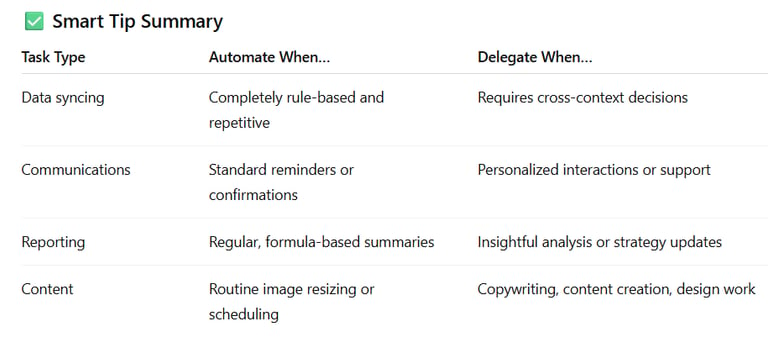What You Can Automate vs. What You Should Delegate
Learn the difference between tasks worth automating and those better off delegated. This guide helps entrepreneurs and solution providers streamline operations, preserve focus, and boost efficiency.
8/11/20252 min read


Not every repetitive task requires your direct attention—or automation.
Knowing when to automate and when to delegate empowers you to work smarter, not harder.
This guide helps you draw the line, so your time stays focused on high-impact, strategic work.
1. What You Can (and Should) Automate
Automate tasks that are repetitive, rule-based, and do not require creative judgment.
Automation reduces manual effort, minimizes errors, and frees your brainpower for strategic challenges.
Use tools like Zapier, Integromat/Make, or native integrations to sync data between platforms
Automate recurring communications—like confirmation emails, reminders, or status updates
Schedule social media posts via platforms like Buffer, Hootsuite, or native scheduling tools
Use spreadsheet formulas, scheduled reports, and dashboards to calculate and visualize data automatically
2. What You Should Delegate
Delegate work that needs judgment, personalization, or a human touch—especially tasks that follow frameworks but benefit from adaptability.
Delegation lets you tap into expertise, maintain quality, and avoid burnout from repetitive but strategic tasks.
Creative tasks like blog writing, graphic design, or content repurposing
Client onboarding, support workflows, or relationship-building communications
Complex project management, organization, and research coordination
Specialized work such as legal, bookkeeping, video editing, or web development
3. Why This Division Matters
Knowing the difference between automation and delegation creates a smarter workflow system.
It helps you avoid over-automation where nuance is needed and underuse of talent where creativity adds value.
Automation saves time but can’t handle exceptions or brand tone
Delegation preserves quality and strategy—vital where decisions matter
Balancing both reduces friction, boosts consistency, and frees mental space
4. How to Implement This in Practice
Start by listing all recurring tasks and categorizing them into automatable vs delegable.
Then identify tools or people to take over these tasks, and establish accountability and quality monitoring.
Audit your weekly task list and separate each task by type
For automation: document workflows and build them using tools like Zapier or Airtable
For delegation: create SOPs, training materials, and handover guidance for tasks
Monitor results regularly and adjust automation or delegation levels over time
✅ Smart Tip Summary
Conclusion
Automation and delegation are powerful tools when used together. Automate predictable, repetitive work—and delegate nuanced, judgment-based tasks to trusted people. This strategy helps you reclaim productivity and focus on what truly matters.
Need help setting up automation workflows or building delegation-ready teams and systems? Saravapro can help you scale efficiently—without losing clarity or control.








SARAVA PRO
Expert virtual assistance for your business needs.
Contact us
Focus
+91 9952642607


